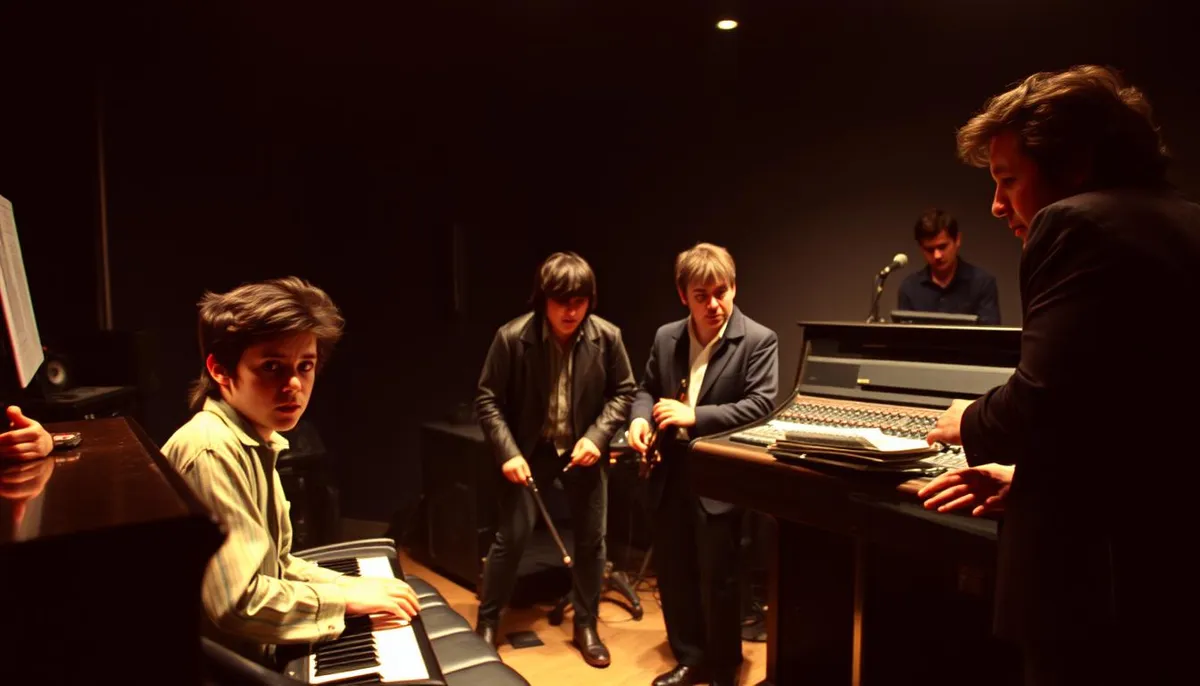The group Culture Club is one of the emblems of the 1980s, known for its unique blend of musical styles and its charismatic singer, Boy George.

Formed in London in 1981, Culture Club quickly conquered international charts with hits like “Do You Really Want to Hurt Me” and “Karma Chameleon.”
This introduction will outline the highlights of this iconic group's career, its impact on the music scene of the 1980s, and the reasons for its global success.
The musical influence of Culture Club transcended the simple pop sphere to become a true societal phenomenon, with Boy George at its helm. Their diverse musical influence shaped the sound of an entire generation.
The Origins of Culture Club
It was in the London district of Covent Garden that the roots of Culture Club were laid. This trendy area of London was the site of a decisive meeting in April 1981 between Boy George and Mikey Craig, which would mark the beginning of an exceptional musical adventure.
The Decisive Meeting at Covent Garden
Mikey Craig, a former DJ and self-taught bassist, discovered Boy George, then known as Lieutenant Lush in the band Bow Wow Wow, through a photo published in the New Musical Express. Intrigued by the character, Mikey Craig wanted to meet Boy George to form a band together. This meeting took place at the Planets club, where Boy George worked as a disc jockey.
The meeting between these two personalities was the catalyst for the creation of Culture Club. Their shared passion for music and artistic vision laid the foundation for what would become one of the most iconic groups of the 80s.
The Formation of the Band in 1981
After the meeting between Boy George and Mikey Craig, the band began to take shape with the arrival of Jon Moss, an experienced drummer who had played with several punk bands, and Roy Hay, a talented guitarist and keyboardist. Together, they formed a multicultural band that would reflect the diversity of their backgrounds.
The name “Culture Club” was chosen in reference to the cultural diversity of its members. Before settling on this name, the band explored several other options, but ultimately “Culture Club” prevailed, symbolizing the union of different cultures and musical styles.
| Member | Role | Contribution |
|---|---|---|
| Boy George | Singer | Charismatic voice and stage presence |
| Mikey Craig | Bassist | Rhythmic foundation and energy |
| Jon Moss | Drummer | Rhythm and dynamics |
| Roy Hay | Guitarist and Keyboardist | Sound textures and melodies |
The Members of Culture Club
Behind the success of Culture Club were four unique personalities who contributed to shaping their distinctive sound. The band was a true mosaic of talents and styles that fused to create innovative and captivating music.
Boy George: The Charismatic Singer
Boy George, born George O'Dowd, was born on June 14, 1961, in Bexley, London. With his androgynous style and soulful voice, he defined the group's image. As the charismatic leader, Boy George brought a unique touch to Culture Club's music.
Mikey Craig: The Founding Bassist
Mikey Craig, born Michael Emile Craig on February 15, 1960, in Hammersmith, London, played a crucial role in the creation of the band. As the founding bassist, he brought Caribbean influences that shaped Culture Club's unique sound.
Jon Moss: The Experienced Drummer
Jon Moss, born Jonathan Aubrey on September 11, 1957, in Wandsworth, London, joined Culture Club with his experience as a drummer who had played with punk bands like The Damned and The Clash. His technical expertise was essential to the band.
Roy Hay: The Guitarist and Keyboardist
Roy Hay, born Roy Ernest Hay on August 12, 1961, in Southend-on-Sea, Essex, completed the lineup of Culture Club after an audition in July 1981. As a talented guitarist and keyboardist, he brought an essential musical dimension to the band.
The cultural and musical diversity of these four members, including elements of guinean craftsmanship, contributed to creating a unique sound that defined an era. Their collaboration gave birth to unforgettable hits that continue to resonate in today's pop music.
- Culture Club was composed of four talented members: Boy George, Mikey Craig, Jon Moss, and Roy Hay.
- Each member brought their own unique style and talent to the group.
- The diversity of the group was key to their musical success.
The Unique Musical Style of Culture Club
Culture Club made its mark on pop music history with its innovative approach. Their unique musical style is the result of a blend of genres and diverse influences, creating an impactful hook that resonates with audiences.
The band managed to merge elements of pop, soul, reggae, calypso, and new wave to create a distinctive sound that captivated audiences in the 80s.
A Multicultural Blend of Genres
The music of Culture Club is characterized by its diversity. The Caribbean influences of Mikey Craig brought reggae and calypso rhythms, particularly in tracks like “Love Twist” and “I’ll Tumble 4 Ya.”
These influences created a distinctive rhythmic foundation that contributed to the band's success.
The Musical Influences of the Band
Each member of the band brought their own musical influences. Roy Hay introduced sophisticated jazz chords and multi-layered arrangements inspired by Steely Dan.
Jon Moss's experience in punk rock bands and his taste for jazz-rock and soul reinforced Culture Club's characteristic groove.
As for Boy George, his major influences come from Philadelphia soul and 70s British pop, shaping his unique vocal style.
| Member | Influence | Contribution to the Band |
|---|---|---|
| Mikey Craig | Reggae and calypso rhythms | Distinctive rhythmic foundation |
| Roy Hay | Jazz chords and multi-layered arrangements | Enrichment of the band's sound |
| Jon Moss | Punk rock, jazz-rock, and soul | Reinforcement of the groove |
| Boy George | Philadelphia soul and British pop | Unique vocal style |
The Difficult Beginnings and Early Recordings
The journey of Culture Club began with considerable challenges before their rise to the top of the music scene. The band faced several rejections before successfully breaking into the music industry.
During their early days, the band recorded several demos for the record label EMI, which unfortunately were not selected. These demos included unreleased tracks such as “I’m An Animal,” “Kissing to Be Clever,” “The Eyes of Medusa,” and “Put it Down.” These songs were not included in their first album.
Rejected Early Demos
The early demos recorded by Culture Club were rejected by EMI. These demos, partially recorded with John Suede on guitar, represented the band's first steps into the music industry. “The Eyes of Medusa” and “Put it Down” were the first songs composed by Boy George and Roy Hay, marking the beginning of their contribution to the band's repertoire.
Unsuccessful First Singles
The band's first two singles, “White Boy” and “I’m Afraid of Me,” released in May and June 1982 respectively, did not achieve the expected success in the UK and European charts. These initial failures were significant obstacles for the band, but also contributed to their resilience and determination.
| Title | Release Date | Reception |
|---|---|---|
| White Boy | May 1982 | Commercial failure |
| I’m Afraid of Me | June 1982 | Commercial failure |
Despite these difficult beginnings, Culture Club continued to work on their music and style, which eventually led to their breakthrough with their first album, “Kissing to Be Clever.” This period in their career was crucial in forging their musical identity and preparing them for future success. Additionally, the capacity of the palace of culture played a significant role in hosting events that showcased their evolving sound.

The Meteoric Rise with “Do You Really Want to Hurt Me”
The release of ‘Do You Really Want to Hurt Me’ during the summer of 1982 marked a decisive turning point in Culture Club's career. This track, supported by the record label, forever changed the fate of the English group. With a catchy melody blending pop and reggae, ‘Do You Really Want to Hurt Me’ became the must-have hit of late 1982.
The International Success of the Single
After two singles that did not achieve success, Culture Club experienced a meteoric rise with the release of “Do You Really Want to Hurt Me.” This single made its radio debut on the Peter Powell Show on BBC Radio One. Shortly after, the band appeared on popular music shows, Top of the Pops and The Late Breakfast Show, which propelled the track to the top of the charts in Britain.
The success was instantaneous, with sales reaching six and a half million copies worldwide. The single topped the charts in England, France, Australia, and across Europe. This global success solidified Culture Club's position as a leading group in the music scene of the 80s.
The Media Impact in France and Europe
In France, Culture Club was discovered through the show “Les Enfants du rock” by Philippe Manœuvre and Jean-Pierre Dionnet. The visual impact of Boy George's androgynous look captivated viewers of the time. The French audience embraced the band, with over a million 45s sold. Additionally, the appreciation for local cuisine belfort added to the cultural richness that surrounded the band's rise to fame.
The media impact of “Do You Really Want to Hurt Me” was considerable, not only in France but throughout Europe. Television appearances and radio play contributed to its success. The song became a symbol of the era, representing the pop and innovative spirit of Culture Club. If you're curious about how to use the culture pass, it can enhance your experience of cultural events related to such iconic music.
The Album “Kissing to Be Clever”: The First Triumph
With ‘Kissing to Be Clever’, Culture Club presents its first album, a reflection of its talent and originality. Released in October 1982, this album was produced by Steve Levine and marked an important milestone in the band's career.
The Release and Reception of the Album
The album ‘Kissing to Be Clever’ consists of several energetic tracks that blend pop, rock, new wave, soul, and Caribbean rhythms. This musical diversity makes the album a coherent and innovative whole. Upon its release, the album received a favorable reception from both the public and critics.
Critics praised the band's ability to merge different musical styles into a unique sound. This originality allowed Culture Club to stand out on the international music scene.
The Successful Singles from the Album
Three major singles were released from the album: “Do You Really Want to Hurt Me,” “I’ll Tumble 4 Ya,” and “Time (Clock of the Heart).” These songs achieved great success and contributed to the album's popularity.
- “I’ll Tumble 4 Ya” with its catchy Caribbean sounds
- “Time (Clock of the Heart)” which reached the 7th place in the French charts in February 1983
- “Love Twist” which completes the list of successful tracks from the album
Thanks to these singles, the album remained present in the French charts for 72 weeks, even reaching the second place in best-selling albums. This success allowed Culture Club to become an essential figure in the global music scene.
The impact of ‘Kissing to Be Clever’ is significant, not only in France but also internationally. The album helped establish Culture Club's reputation as an innovative and talented group in the world of pop music, similar to how gemology has established its own niche in the study of precious stones.
The Pinnacle with “Colour by Numbers”
Culture Club's second album, “Colour by Numbers,” released in 1983, established the group as an international superstar. This album represents the pinnacle of their career, with hits that conquered the world.
“Karma Chameleon”: The Group's Biggest Success
The first single from the album, “Karma Chameleon,” became a global phenomenon. It reached number one in 16 countries and sold 7 million copies worldwide, including 720,000 in France. This track confirmed Culture Club's status as one of the most popular groups of the time.
The Other Hits from the Album
The album “Colour by Numbers” contains several other notable hits. These include “It’s a Miracle,” a pop-funk track with an original video featuring the band in a giant Trivial Pursuit. “Church of The Poison Mind” is another standout track, featuring English singer Helen Terry on soulful vocals. “Miss Me Blind” oscillates between rock guitar and funk guitar, with a video directed by Steve Barron. Darker tracks like “Victims” and “Black Money” close this series of hits.
- “It’s a Miracle” – A pop-funk track with an innovative video.
- “Church of The Poison Mind” – Featuring Helen Terry.
- “Miss Me Blind” – A mix of rock and funk.
- “Victims” and “Black Money” – The darker tracks of the album.
The Awards and Recognitions
The album “Colour by Numbers” was an exceptional commercial success, selling over 10 million copies worldwide. It was certified gold in France with 100,000 copies sold, triple platinum in the UK, and quadruple platinum in the United States. In 1984, Culture Club received numerous awards, including the Grammy Award for “Best New Artist,” the BPI Awards for “Best Group,” and the BBC Rock & Pop Awards for Boy George as “Pop Personality of the Year.”
These awards and recognitions solidified Culture Club's position as one of the leading groups of the 80s, with Boy George at the forefront. The album “Colour by Numbers” remains an important milestone in the history of pop music.
The World Tour of 1984
After the phenomenal success of the album ‘Colour by Numbers’, Culture Club launched a world tour in 1984, confirming their status as international superstars. This tour, known as the ‘Colour by Numbers Tour’, began triumphantly in North America.
The Triumph in North America
The tour began in North America, with acclaimed concerts in Montreal, Ottawa, Detroit, Atlanta, and Nashville. The North American audience warmly welcomed the British group, demonstrating their enthusiasm for Culture Club. However, the tour was not without incident. On April 5 in Columbus, Ohio, drummer Jon Moss was the potential target of an armed shooter who showed up at their hotel suite door.
The Conquest of Japan and Australia
The tour continued successfully in Japan from June 17 to 27, and in Australia from June 28 to July 14, 1984. The group garnered local support, confirming their global popularity. In Adelaide, Australia, the band's popular impact was notable, with between 10,000 and 25,000 fans flooding Rundle Mall to catch a glimpse of the four British musicians.
| City | Date | Event |
|---|---|---|
| Montreal | March 1984 | Acclaimed concert |
| Columbus | April 5, 1984 | Incident with an armed shooter |
| Adelaide | June/July 1984 | 10,000 to 25,000 fans at Rundle Mall |

The world tour of Culture Club in 1984 was a resounding success, consolidating their place in the music world. The concerts were energetic, and fans responded enthusiastically, making this tour an unforgettable experience for the band and its audience.
The Decline with “Waking Up with the House on Fire”
After the meteoric success of ‘Colour by Numbers’, Culture Club experienced a notable artistic decline with their third album. “Waking Up with the House on Fire,” released in October 1984, was a disappointment for both critics and fans who eagerly awaited the follow-up to their previous opus.
A Disappointing Album
The album was criticized for its songs deemed rushed and less inspired melodies. The band seemed to have lost the creativity and soul that characterized their early days. Despite this, the album achieved some commercial success, particularly in France where it sold 100,000 copies, and reached 5 million sales worldwide.
The Reasons for Commercial and Critical Failure
Several factors contributed to the relative failure of “Waking Up with the House on Fire.” The band's state of exhaustion after two years of intense activity and world tours likely played a major role. Additionally, the application for a cultural grant could have provided the necessary support for their creative endeavors, but the lack of creativity and innovation in the compositions was also a determining factor. Despite these criticisms, the album became a commercial success, achieving platinum certifications in England and the United States.
In summary, the “Waking Up with the House on Fire” marks a turning point in the career of Culture Club, representing both an artistic decline and a mixed commercial success. The band continued to evolve despite this failure, and many aspiring musicians, including those preparing for the general culture exam bts, can learn from their journey, but never regained the same magic that characterized their beginnings.
The Secret Relationship between Boy George and Jon Moss
The secret affair between Boy George and Jon Moss was a determining factor in the creation and evolution of Culture Club. This relationship, which remained hidden from the public for a long time, played a crucial role in inspiring some of the band's most iconic songs.
A Love Story at the Origin of the Band
Boy George and Jon Moss met under circumstances that changed their lives forever. “He arrived in a very expensive convertible Golf that smelled of perfume, with his earrings,” Boy George recalls, describing their first meeting. “It was love at first sight, basically.” Jon Moss shared this feeling, admitting he was “really attracted to him” despite never having had a relationship with a man before.
The Influence on Music and Lyrics
This tumultuous relationship had a significant influence on the music and lyrics of Culture Club. Songs like “Do You Really Want to Hurt Me” and “Victims” can be interpreted as direct references to their complicated love story. The band's creativity was nourished by this relationship, even though it was also a source of tensions that contributed to the group's later dissolution.
The relationship between Boy George and Jon Moss is an example of how personal experiences can shape art. Their love story, while secret at the time, remains an integral part of Culture Club's legacy.
The Musical Legacy of Culture Club
With their unique style, Culture Club revolutionized 80s pop by creating a bridge between different musical genres such as pop, soul, reggae, and funk. This fusion of styles not only contributed to shaping the evolution of modern pop but also played a crucial role in diversifying the music industry. Additionally, the benefits of kadéos vouchers can enhance the experience of fans engaging with their music and merchandise.
Impact on 80s Pop
Culture Club had a considerable impact on 80s pop, notably by breaking racial and sexual barriers in the music industry. Their music transcended genres and borders, reaching a global audience.
- Their androgynous style and eclectic music challenged conventions.
- They paved the way for greater acceptance of diversity in popular culture.
- Their influence is seen in how contemporary artists blend musical genres.
Influence on Contemporary Artists
The influence of Culture Club is still felt today among contemporary artists. Many musicians cite Culture Club as a major source of inspiration for their own work.
Artists such as George Michael and Scissor Sisters have mentioned the impact of Culture Club on their music. This influence translates into a continuation of Culture Club's legacy in modern music.
In summary, the musical legacy of Culture Club is undeniable. Their contribution to 80s pop and their influence on subsequent generations of artists solidify their place as pioneers of pop music.
Conclusion: Culture Club, Timeless Icons of Pop
Culture Club remains one of the most iconic groups of the 80s music scene. Their music, characterized by a unique blend of styles, captivated the world and continues to resonate today.
From their humble beginnings in London to their status as a global phenomenon, Culture Club has sold over 50 million records and created timeless hits that remain played and covered. Their multicultural approach to music and the non-conformist image of Boy George challenged the conventions of the time, contributing to their success.
The impact of Culture Club on popular culture is undeniable. They expanded the musical horizons of the public and promoted values of tolerance and acceptance of difference. Their influence is still felt on the contemporary music scene.
Ultimately, Culture Club remains timeless icons of pop. Their music continues to touch new generations of listeners, ensuring their musical legacy for years to come. With their unique style and memorable songs, they remain a reference in the world of music.
RelatedRelated articles


